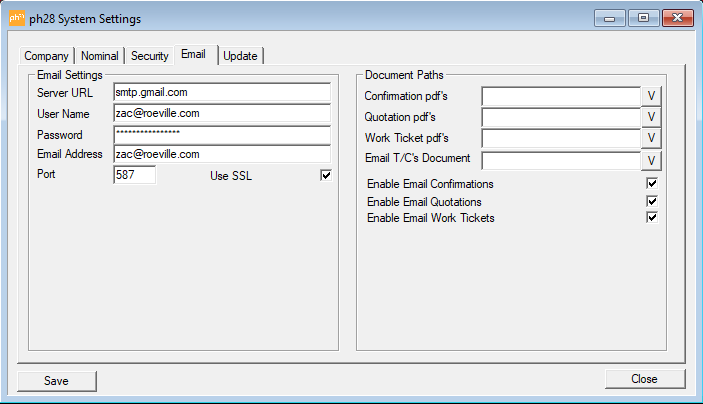Setting up SMTP for Gmail
This article provides step-by-step instructions for setting up Gmail for t3, PHCloud, Ph28, and t28
Due to Google's security requirements, 2FA is required for Gmail setup. This adds an extra layer of security to your Google account by sending authorization codes to your phone. It ensures that physical ownership of a device is required for initially logging in, and not just the password itself.
Step 1: Log into Google
Go to www.google.com and log in using your Google account credentials.
Step 2: Enable 2-Step Verification
Click on your profile icon in the top-right corner of the screen.
Click on "Google Account."
Click on "Security" on the left-hand side of the screen.
Under "Signing in to Google," click "2-Step Verification."
Click "Get Started" and follow the instructions to enable 2-Step Verification.
Step 3: Generate an app password for SMTP authentication.
Select the app from the drop-down choice and choose "Other
(Custom Name)."
Give it the name "Roeville Email" and select "Generate".
This will then pop up with an app password, which you need to note down to save for later.
 If you do not save the password during this step, you will not be able to recover it afterwards and will need to repeat step 3
If you do not save the password during this step, you will not be able to recover it afterwards and will need to repeat step 3Setting up SMTP in your software

The following steps may differ slightly depending on which product you are using:
PhCloud:
Enter the email settings section of PHCloud (Located under Settings -> Company Profile -> Email Settings)
Fill out the details accordingly:
Email From Address: [Your Gmail email]
Email From Display Name: [Your Company Name]
SMTP Domain: gmail.com
Use SSL?: True
SMTP Server: smtp.gmail.com
SMTP Password: [The 16 digit password generated during step #3]
SMTP Port: 587
SMTP Username: [Your Gmail email]
SMTP Server: smtp.gmail.com
SMTP Password: [The 16 digit password generated during step #3]
SMTP Port: 587
SMTP Username: [Your Gmail email]
t3:
Enter the email settings for t3, located under Maintain -> Settings -> Email.
Fill out the details accordingly:
Server URL: smtp.gmail.com
User Name: [Your Gmail email]
Password: [The 16 digit password generated during step #3]
Email Address: [Your Gmail email]
Port: 587
Use SSL: True
Ph28:
Enter the email settings for ph28, located under Maintain -> Settings -> Email
Fill out the details accordingly:
Server URL: smtp.gmail.com
User Name: [Your Gmail email]
Password: [The 16 digit password generated during step #3]
Email Address: [Your Gmail email]
Port: 587
Use SSL: True

Port: 587
Use SSL: True
t28:
Enter the email settings for t28, located under Maintain -> Settings -> Email
Fill out the details accordingly:
Server URL: smtp.gmail.com
Port: 587
Use SSL: True
Fill out the details accordingly:
Server URL: smtp.gmail.com
User Name: [Your Gmail email]
Password: [The 16 digit password generated during step #3]
Email Address: [Your Gmail email]Port: 587
Use SSL: True
Related Articles
Registering Outlook & 365 Email Accounts with Open Authorisation
What is OAuth and why is it required ? Microsoft has recently taken the decision to implement OAuth2 as the standard authentication process for online email applications. The traditional method of SMTP authentication, requiring a username and ...Setting up SMTP for Outlook
This article provides step-by-step instructions for setting up Outlook for t3, PHCloud, Ph28, and t28. Depending on if your emails are managed by an external IT support company, you may need your IT to carry out these steps. Step 1: Log into the 365 ...How to add attachments and create an email template
This article assists with personalising your emailed documentation and how to include any additional attachments, that may be required to support the document. Adding an attachment Located via the settings menu, browse to the following section. ...Creating a new booking
When using PHCloud, you can create bookings for various types of travel, including one-time or infrequent trips between different locations. These bookings commonly involve events such as weddings, airport transportation, or any other occasion that ...Updating the email password in t3
If t3 suddenly stops sending confirmations via email then the most likely cause of this will be that the password for the email account that t3 uses has been changed and t3 will need to be updated with the new password. Updating the password in t3 ...